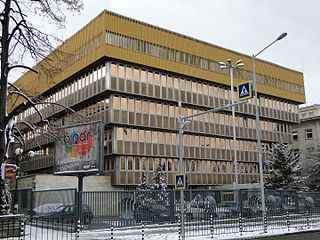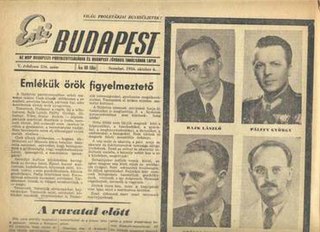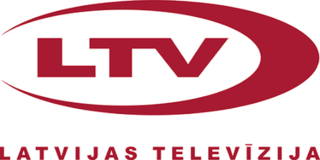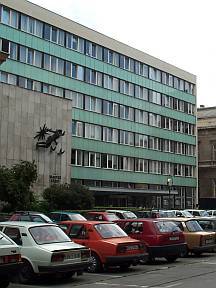 W
WThe Belarusian Telegraph Agency or BelTA is the state-owned national news agency of the Republic of Belarus. It operates in Russian, Belarusian, English, German, Spanish and Chinese languages. Since 2018, the director of BELTA is Irina Akulovich
 W
WThe Berliner Zeitung is a daily newspaper based in Berlin, Germany. It was founded in East Germany in 1945 and continued publication after reunification.
 W
WBNT 2 is a Bulgarian state-owned TV channel, operated by the Bulgarian National Television. It is the successor to the defunct second program of the national television - Efir 2. Launched on October 16, 2011 the channel replaced the five regional television centers of BNT - BNT Pirin, BNT More, BNT Sever, BNT Plovdiv and BNT Sofia by combining their programmes into one. The new channel broadcasts original programs, newscasts and sporting events. The program includes a "Regional programming bloc" with local opt-out broadcasts of the former regional television centres. It also broadcasts sport events like National Basketball League (Bulgaria), volleyball and other.
 W
WBulgarian National Radio is Bulgaria's national radio broadcasting organisation. It operates two national and seven regional channels, as well as an international service – Radio Bulgaria – which broadcasts in 11 languages.
 W
WThe Bulgarian National Television or BNT (БНТ) is the public broadcaster of Bulgaria. BNT was founded in 1959 and started broadcasting on December 26 of the same year. It was the first television service to broadcast on the territory of Bulgaria.
 W
WCzechoslovak Television (ČST) was founded on 1 May 1953 in Czechoslovakia. It was known by three names over its lifetime: Czech: Československá televize, Slovak: Československá televízia, Česko-slovenská televízia.
 W
WChannel One is the first television channel to broadcast in the Russian Federation. Its headquarters are located at Ostankino Technical Center near the Ostankino Tower in Moscow.
 W
WČT2 is Czech public television channel, operated by Česká televize. ČT2 broadcasts documentaries nature-oriented shows, frequently showing foreign films in the original versions with Czech subtitles, including many English-language movies and features some of the important sports events.
 W
WDeutschlandsender, abbreviated DLS or DS, was one of the longest-established radio broadcasting stations in Germany. The name was used between 1926 and 1993 to denote a number of powerful stations designed to achieve all-Germany coverage.
 W
WDziennik Telewizyjny, commonly simplified to Dziennik, was the chief news program of Telewizja Polska between 1958 and 1989, in the Polish People's Republic. It was Poland's second regularly televised newscast and the primary propaganda tool used by the Polish United Workers' Party during the Cold War. The final episode aired on 17 November 1989 and the program was replaced by Wiadomości on the following day, 18 November 1989.
 W
WEastern Bloc media and propaganda was controlled directly by each country's Communist party, which controlled the state media, censorship and propaganda organs. State and party ownership of print, television and radio media served as an important manner in which to control information and society in light of Eastern Bloc leaderships viewing even marginal groups of opposition intellectuals as a potential threat to the bases underlying Communist power therein.
 W
WEsti Budapest was a Hungarian newspaper. It was published daily from 2 April 1952 to 23 October 1956.
 W
WIzvestia is a daily broadsheet newspaper in Russia. It was a newspaper of record in the Soviet Union from 1917 until the dissolution of the USSR in 1991.
 W
WKomsomolskaya Pravda is a daily Russian tabloid newspaper, founded on 13 March 1925.
 W
WKomunisti, was a daily newspaper published by the Georgian Communist Party Central Committee. The first number was issued on June 3, 1920 in Tbilisi as the daily organ of the Communist Party of Georgia and the Central Committee of the Communist Party, named "New Communist". After the publication of 10 numbers, the newspaper was closed down by the General-Governor of Tbilisi. During the first government of independent Georgia the newspaper was named "Georgia Communist". After the establishment of the Soviet government in Georgia on March 2, 1921, it was renamed Komunisti.
 W
WKrasnaya Nov was a Soviet monthly literary magazine
 W
WKurier Wileński is the main Polish-language newspaper in Lithuania. Printed in Vilnius, it is the only Polish-language daily newspaper published east of Poland. A direct descendant of both the 19th-century newspaper of the same name and the Czerwony Sztandar newspaper, created by the Soviet authorities in 1953 as a means of Sovietization of the Polish diaspora left in the Polish areas annexed by the Soviet Union. The newspaper is a member of the European Association of Daily Newspapers in Minority and Regional Languages (MIDAS). According to TNS Gallup media research, Kurier Wileński 36,800 people or 1.4% of Lithuania's population read at least one issue out of the last six in summer 2008, but that measure dropped to 0.3% in spring 2010.
 W
WLatvijas Radio is Latvia's national public-service radio broadcasting network. It began broadcasting on 1 November 1925, and has its headquarters in the Latvian capital, Riga. Latvijas Radio broadcasts six different channels in the FM band as well as via the internet: Latvijas Radio 1, Latvijas Radio 2, Latvijas Radio 3 Klasika, Latvijas Radio 4 Doma laukums, Latvijas Radio 5 Pieci.lv, and Latvijas Radio 6 – Radio NABA.
 W
WLatvijas Televīzija is the state-owned public service television broadcaster in Latvia. LTV operates two channels, LTV1 in Latvian and LTV7 in Latvian with selected programming in Russian.
 W
WM1 is a Hungarian television channel owned and operated by Magyar Televízió. It is also transmitted in high definition.
 W
WM2 is a Hungarian television channel owned and operated by Magyar Televízió. It is also transmitted in high definition.
 W
WMagyar Rádió is Hungary's publicly funded radio broadcasting organization. It is also the country's official international broadcasting station.
 W
WRadio Moscow, also known as Radio Moscow World Service, was the official international broadcasting station of the Union of Soviet Socialist Republics until 1993. It was reorganized with a new name: Voice of Russia, which has also since been reorganized and renamed Radio Sputnik. At its peak, Radio Moscow broadcast in over 70 languages using transmitters in the Soviet Union, Eastern Europe, and Cuba.
 W
WThe National State TV and Radio Company of the Republic of Belarus, Belteleradio, is the state television and radio broadcasting service in Belarus. In 1993 it was admitted as a full active member of the European Broadcasting Union under the name Belarusian Television and Radio Company (BTRC).
 W
WThe New Times is a Russian language magazine in Russia. The magazine was founded in 1943. The current version, established in 1988,, is a liberal, independent Russian weekly news magazine, publishing for Russia and Armenia. Its chief editor is Russian investigative journalist, political scientist, writer and radio host Yevgenia Albats.
 W
WNIN is a weekly newsmagazine published in Belgrade, Serbia. Its name is an acronym for Nedeljne informativne novine which roughly translates into Weekly Informational Newspaper.
 W
WPACO was the name of the official Mondpaca Esperantista Movado (MEM) magazine.
 W
WPolskie Radio Spółka Akcyjna is Poland's national public-service radio broadcasting organization owned by the government of Poland.
 W
WPravda is a major centre-left, newspaper in Slovakia. It is owned by PEREX.
 W
WPrinted media in the Soviet Union, i.e., newspapers, magazines and journals, were under strict control of the Communist Party and the Soviet state. The desire to disseminate propaganda is believed to have been the driving force behind the creation of the early Soviet newspapers. Until recently, newspapers were the essential means of communicating with the public, which meant that they were the most powerful way available to spread propaganda and capture the hearts of the populace. Additionally, within the Soviet Union the press evolved into the messenger for the orders from the Central Committee to the party officials and activists. Due to this important role, the Soviet papers were both prestigious in the society and an effective means to control the masses. However, manipulation initially was not the only purpose of the Soviet Press.
 W
WAll-Union Radio was the radio broadcasting organisation for the USSR under Gosteleradio, operated from 1924 until the dissolution of the USSR. The organization was based in Moscow.
 W
WRadio România Actualităţi is the first radio channel in Romania, both in coverage, number of listeners, and timeline. It is owned by the Romanian Radio Broadcasting Company
 W
WRadio România Cultural is the Romanian Radio Broadcasting Corporation's second national channel.
 W
WRadio 3 net is the former Radio România Tineret. More than 20,000 albums are stored on Radio 3 net. A few of the prominent features available on the website are "1001 Albums You Must Hear Before You Die" and "Search & Play".
 W
WRahva Hääl was the official daily newspaper of the Communist Party of Estonia during Soviet occupation of Estonia. It was founded shortly after the first Soviet takeover in 1940 based on offices and resources of Uus Eesti, an earlier Estonian newspaper.
 W
WThe Romanian Radio Broadcasting Company, informally referred to as Radio Romania, is the public radio broadcaster in Romania. It operates FM and AM, and internet national and local radio channels. The local stations are branded under the Radio România Regional umbrella. Radio Romania International is the company's international radio station, broadcasting on two channels in Romanian, English, French, Aromanian, Spanish, German, Italian, Serbian, Russian, Ukrainian, Chinese, and Arabic.
 W
WRadio Televizioni Shqiptar (RTSH) is an Albanian public-service radio and television broadcasting company. Founded in 1938, it operates several radio and television channels, over a domestic transmitter network as well as satellite. The international television service via satellite RTSH Sat was launched in 1993 and is aimed at Albanian-speaking communities in Kosovo, Serbia, North Macedonia, Montenegro, and northern Greece, plus the Albanian diaspora in the rest of Europe. RTSH is funded by a combination of commercial advertising, an annual licence fee of US$12.00 and grant-in-aid from the Albanian government.
 W
WRudé právo was the official newspaper of the Communist Party of Czechoslovakia.
 W
WRundfunk der DDR was the radio broadcasting organisation for the German Democratic Republic (GDR) from 1952 until German reunification, after which it continued until 1991 as Funkhaus Berlin, located at 18-50 Nalepastrasse.
 W
WRycerz Niepokalanej is a Polish Roman-Catholic monthly magazine. It was first published in January 1922, and in Communist Poland its publication was banned from 1952 until 1981. Its founder and first editor-in-chief was Father Maximilian Kolbe, who remained in this post until March 1939.
 W
WSamizdat was a form of dissident activity across the socialist Eastern Bloc in which individuals reproduced censored and underground makeshift publications, often by hand, and passed the documents from reader to reader. The practice of manual reproduction was widespread, due to the fact that most typewriters and printing devices were inventorized and required permission to access. This grassroots practice to evade official Soviet censorship was fraught with danger, as harsh punishments were meted out to people caught possessing or copying censored materials.
 W
WScînteia was the name of two newspapers edited by Communist groups at different intervals in Romanian history. The title is a calque from the Russian Iskra. It was known as Scânteia until the 1953 spelling reform, which replaced the letter  with the phonologically identical Î in all cases.
 W
WSoviet Information Bureau was a leading Soviet news agency, operating from 1941 to 1961.
 W
WThe National Public Broadcasting Company of Ukraine, from 2015 to 2020 stylized as UA:PBC, is the national public broadcaster in Ukraine. As such it was registered on 19 January 2017. In its revamped form the company provides content for its three television and radio channels.
 W
WSygnały Magazyn was a Polish cultural and social magazine published 1933–1939 in Lwów. It was a leading periodical of the leftist Polish intelligentsia. The journal started as a 12-page monthly and was subsequently published once every two weeks, with editions of up to 32 pages. Sygnały was published in the tabloid format, similar to the New York Times at about 56x40 cm.
 W
WSzabad Föld is a weekly newspaper published in Budapest, Hungary.
 W
WTelevision in the Soviet Union was owned, controlled and censored by the state. The body governing television in the era of the Soviet Union was the Gosteleradio committee, which was responsible for both the Soviet Central Television and the All-Union Radio.
 W
WTelewizja Polska S.A. is a Polish state media corporation. It is the largest Polish television network, although viewership has been declining since at least 2010. About a third of TVP's income comes from a broadcast receiver licence, while the rest is covered by government subsidies, commercials and sponsorships.
 W
WTrud is a Russian newspaper.
 W
WTVP3 Łódź is one of the regional branches of the TVP, Poland's public television broadcaster. It serves the entire Łódź Voivodeship.
 W
WTVP1 is the main public television channel of TVP, Poland's national broadcaster. It was the first Polish channel to be broadcast and remains one of the most popular today. TVP1 was launched 23 January 1953.
 W
WTVP 2 is a Polish public mainstream TV channel operated by TVP. Its varied line-up contains a variety of programming although it focuses on entertainment: stand up comedy, comic shows, cabaret, and themed talk shows. TVP2 was launched October 1970.
 W
WZvyazda is a state-owned daily newspaper in Belarus.